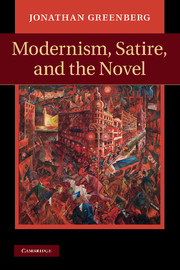Book contents
- Frontmatter
- Contents
- Illustration
- Preface
- Abbreviations
- Chapter 1 Satire and its discontents
- Chapter 2 Modernism's story of feeling
- Chapter 3 The rule of outrage: Evelyn Waugh's Vile Bodies
- Chapter 4 Laughter and fear in A Handful of Dust
- Chapter 5 Cold Comfort Farm and mental life
- Chapter 6 Nathanael West and the mystery of feeling
- Chapter 7 Nightwood and the ends of satire
- Chapter 8 Beckett's authoritarian personalities
- Notes
- Index
Chapter 2 - Modernism's story of feeling
Published online by Cambridge University Press: 07 October 2011
- Frontmatter
- Contents
- Illustration
- Preface
- Abbreviations
- Chapter 1 Satire and its discontents
- Chapter 2 Modernism's story of feeling
- Chapter 3 The rule of outrage: Evelyn Waugh's Vile Bodies
- Chapter 4 Laughter and fear in A Handful of Dust
- Chapter 5 Cold Comfort Farm and mental life
- Chapter 6 Nathanael West and the mystery of feeling
- Chapter 7 Nightwood and the ends of satire
- Chapter 8 Beckett's authoritarian personalities
- Notes
- Index
Summary
Seen through an ever-more-powerful critical microscope, the object once known as modernism is dissolving under our gaze. For some time now new (or renewed) attention to writers who for reasons of race, gender, politics, technique, or talent had been neglected by scholars has radically expanded, undermining a small canon of authors (Joyce, Eliot, Woolf, etc.) and works taken to exemplify Anglo-American high modernism; cultural history has further demanded that maps of modernism make room for popular forms ranging from newspapers to film to jazz. At the same time, the same canonical works have been subjected to new critical approaches in order to reveal their implication in wider social discourses. As a result, an increasing amount of energy has gone into dismantling a high modernism that, we are gradually coming to understand, nobody actually practiced.
At the risk of simplification, however, I follow Pericles Lewis in his contention that the term modernism retains enough coherence to constitute a valuable critical tool. In favoring Lewis's description over Lawrence Rainey's characterization of modernism as merely “a constellation of agents and practices,” or that of critics such as Peter Nicholls who signal the heterogeneity of the era's culture through the plural modernisms, I by no means disdain critical attention to the history of modernist patronage, publication and marketing, nor do I deny that the variety of modernist literature was for years ignored in a myopic reverence for a few great names. I mean, rather, that the work of theorizing modernism does not, for me, conclude with the abandonment of theory; and that I find Lewis's threefold crisis of representation, of liberalism, and of reason to provide a formulation of modernism that is neither too stringent nor too vague. At the same time, however, my own discussion does not center on the categories of technique, politics, and philosophy that have historically dominated discussions of modernism. Instead, I focus on problems of affect, and provide an account of feeling within modernism.
- Type
- Chapter
- Information
- Modernism, Satire and the Novel , pp. 21 - 46Publisher: Cambridge University PressPrint publication year: 2011



